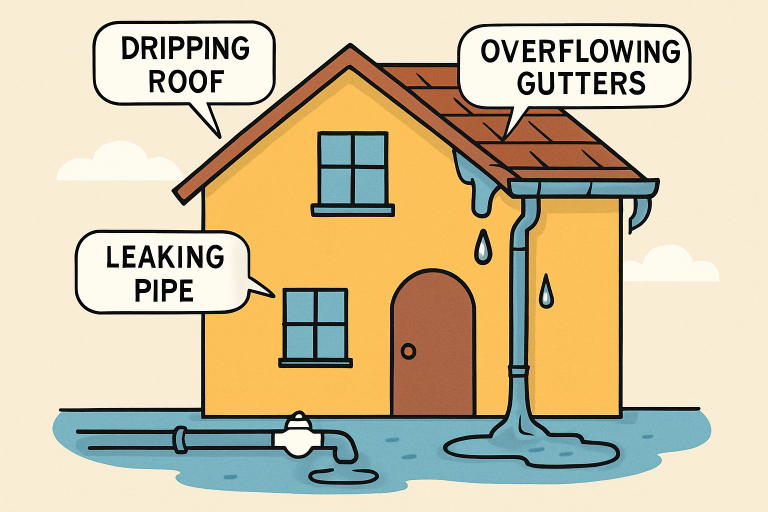Key Takeaways:
- Understanding the common causes of water damage can help prevent it.
- Regular maintenance and inspections are crucial for early detection.
- Taking immediate action can minimize damage and reduce restoration costs.
- Professional restoration services ensure thorough cleanup and repair.
Water damage is a significant issue that affects millions of homes annually, often resulting in costly repairs, property loss, and serious health risks. According to industry estimates, water damage and mold account for nearly one quarter of all insurance claims filed by homeowners. Addressing potential vulnerabilities and knowing how to respond to water emergencies can make a significant difference in protecting your home.
Homeowners who understand the risks, prepare with routine maintenance, and react quickly when a problem arises will mitigate damage and avoid long-term complications. Whether you’re preventing issues or seeking immediate help after a leak, restoration companies such as Remedics can provide professional guidance and services tailored to water, mold, and fire emergencies.
Common Causes of Water Damage
Several factors cause water damage in homes. Leaking pipes from aging, corrosion, or joint failures can lead to serious flooding, hiding damage behind walls and floors. Roof leaks from damaged shingles, worn flashing, or blocked gutters also cause issues, promoting mold and weakening structures. Malfunctioning appliances like washers, dishwashers, water heaters, and refrigerators with ice makers can deteriorate hoses and connections, leading to localized floods. Natural disasters like flash floods, hurricanes, and heavy rains can overwhelm homes, especially with poor landscaping or drainage.

Preventive Measures for Homeowners
The most effective way to minimize water damage is through proactive maintenance and vigilant inspections. Homeowners should regularly inspect visible plumbing for leaks or corrosion, including under sinks, around toilets, and behind appliances. Annual inspections by a licensed plumber can catch hidden issues early. Roof and gutter maintenance is crucial: remove debris twice a year, check shingles after storms, direct downspouts away from the foundation, and consider gutter guards. Installing water detectors in high-risk areas like laundry rooms and basements can give early leak warnings via phone alerts. Proper landscaping, such as sloping yards away from the house and keeping drains clear, also helps prevent water pooling near your foundation.
Signs of Water Damage to Watch For
Early detection helps minimize long-term effects. Look for wall discoloration, bubbling, or staining indicating moisture intrusion. Musty odors indicate the presence of mold or stagnant water behind surfaces. Warped floors indicate water saturation, and a sudden increase in water bills may suggest plumbing issues. Act promptly to identify and resolve issues before costs escalate.
Immediate Steps to Take When Water Damage Occurs
Act quickly when water damage happens: shut off the main water supply, cut power to water-affected outlets, and remove excess water with vacuums or pumps if safe. Ventilate thoroughly using fans, dehumidifiers, and open windows to dry the area and prevent mold. Remove textiles, such as rugs and curtains, for better drying. Document damage with photos to support insurance claims and assess the extent of the damage.
The Role of Professional Restoration Services
Sometimes, a prompt DIY response isn’t enough. Professional restoration services evaluate damage and develop recovery plans. Certified technicians detect hidden moisture, remove mold, and safely eliminate contaminated materials. They address not just visible water but also potential structural issues and ongoing mold, ensuring immediate and long-term safety. Compliance with safety regulations is also secured. If mold is found, immediate professional help is crucial. The EPA provides guidelines for assessing health risks and ensuring safe cleanup.
Understanding Insurance Coverage for Water Damage
After documenting the issue, review your homeowner’s insurance policy to see what water damage is covered. Many policies cover sudden, accidental damage, but may exclude gradual leaks or floods unless you have additional flood insurance. File your claim promptly and collaborate with your insurance adjuster, keeping copies of invoices, photos, and communications.
Conclusion
Water damage remains a common—and preventable—threat to homes everywhere. By understanding the causes, staying ahead with regular maintenance, and knowing the immediate steps to take, you can keep your property and family safe from the most costly and dangerous effects of water intrusion. For serious incidents or prolonged water exposure, consulting experienced professionals is the best way to ensure your home is fully restored and protected for the future.